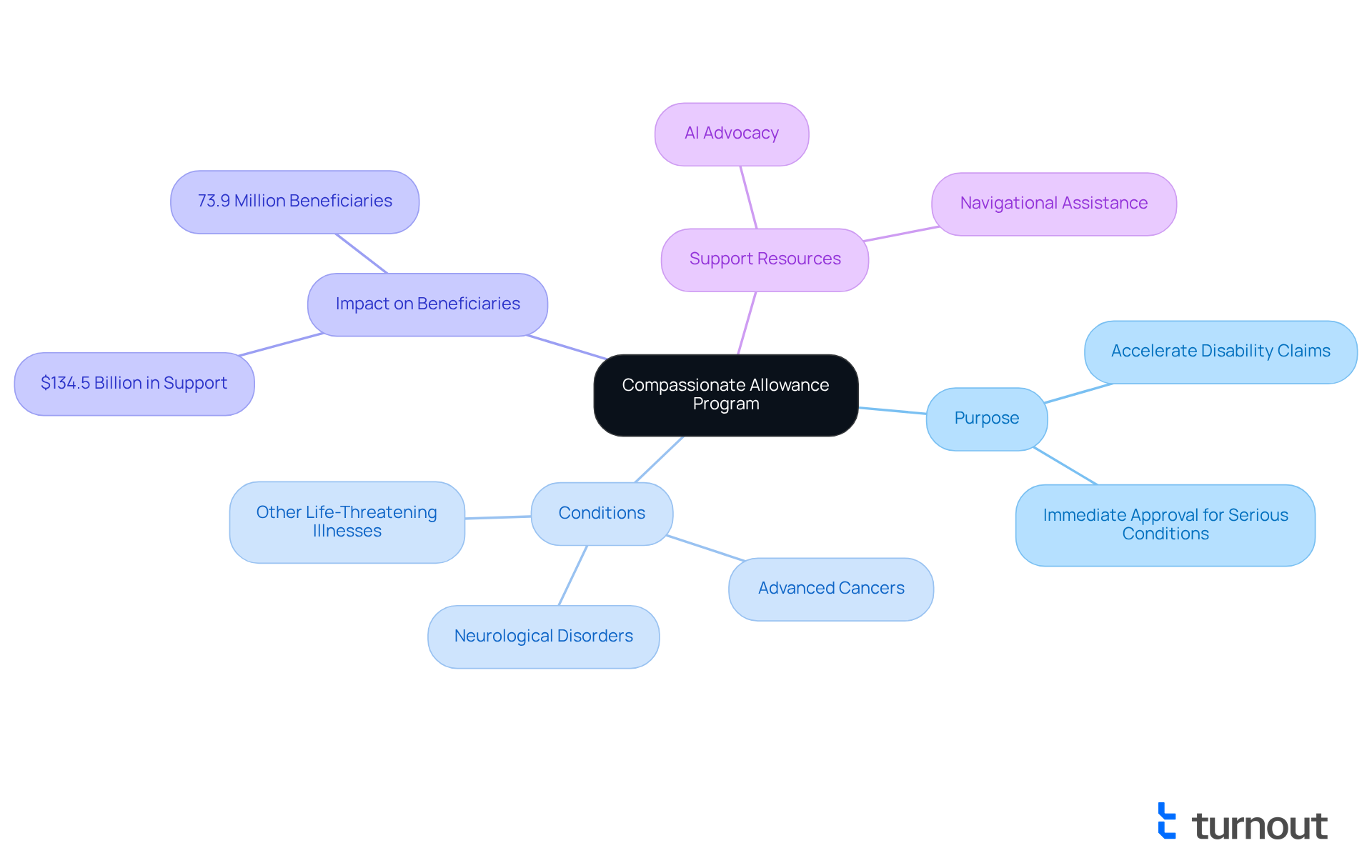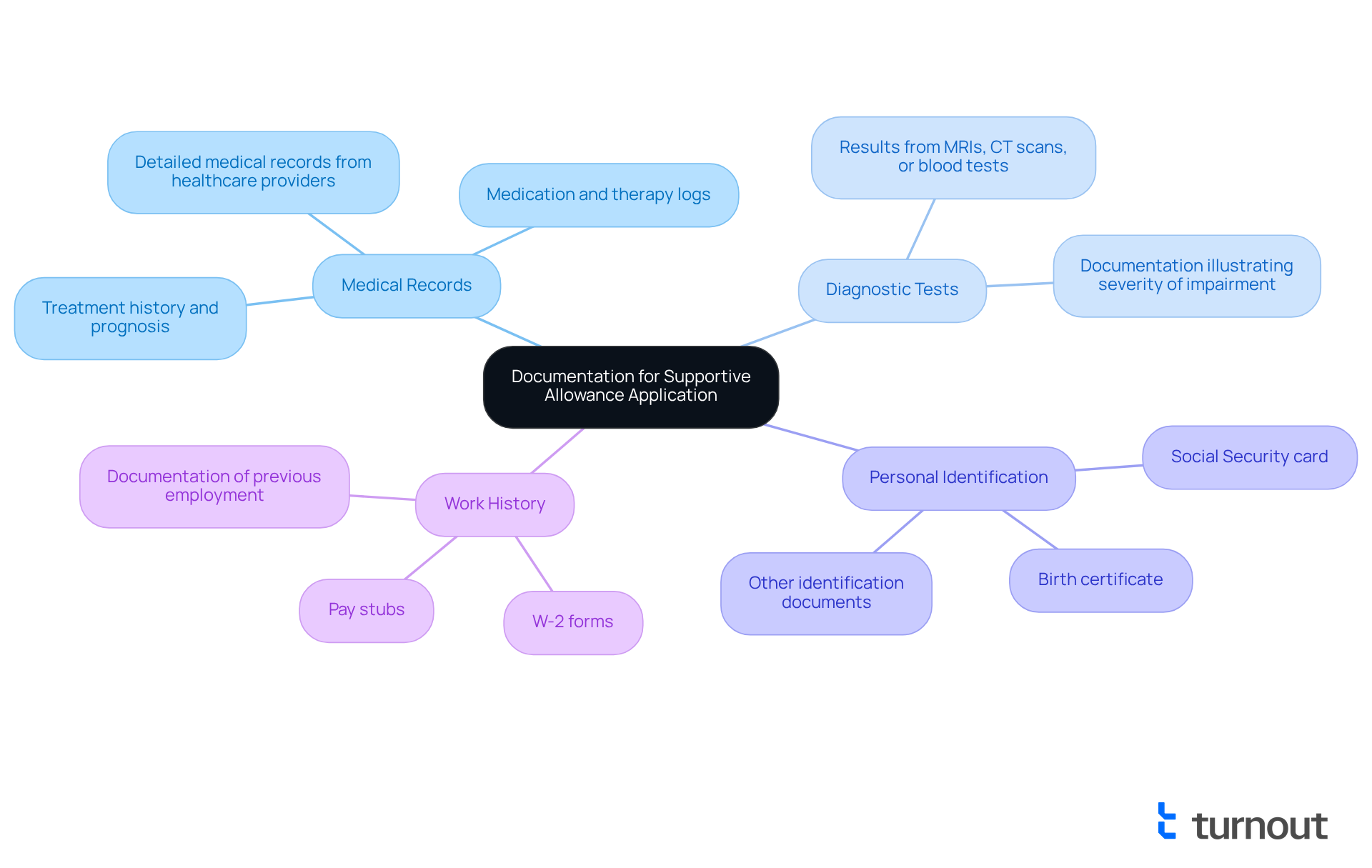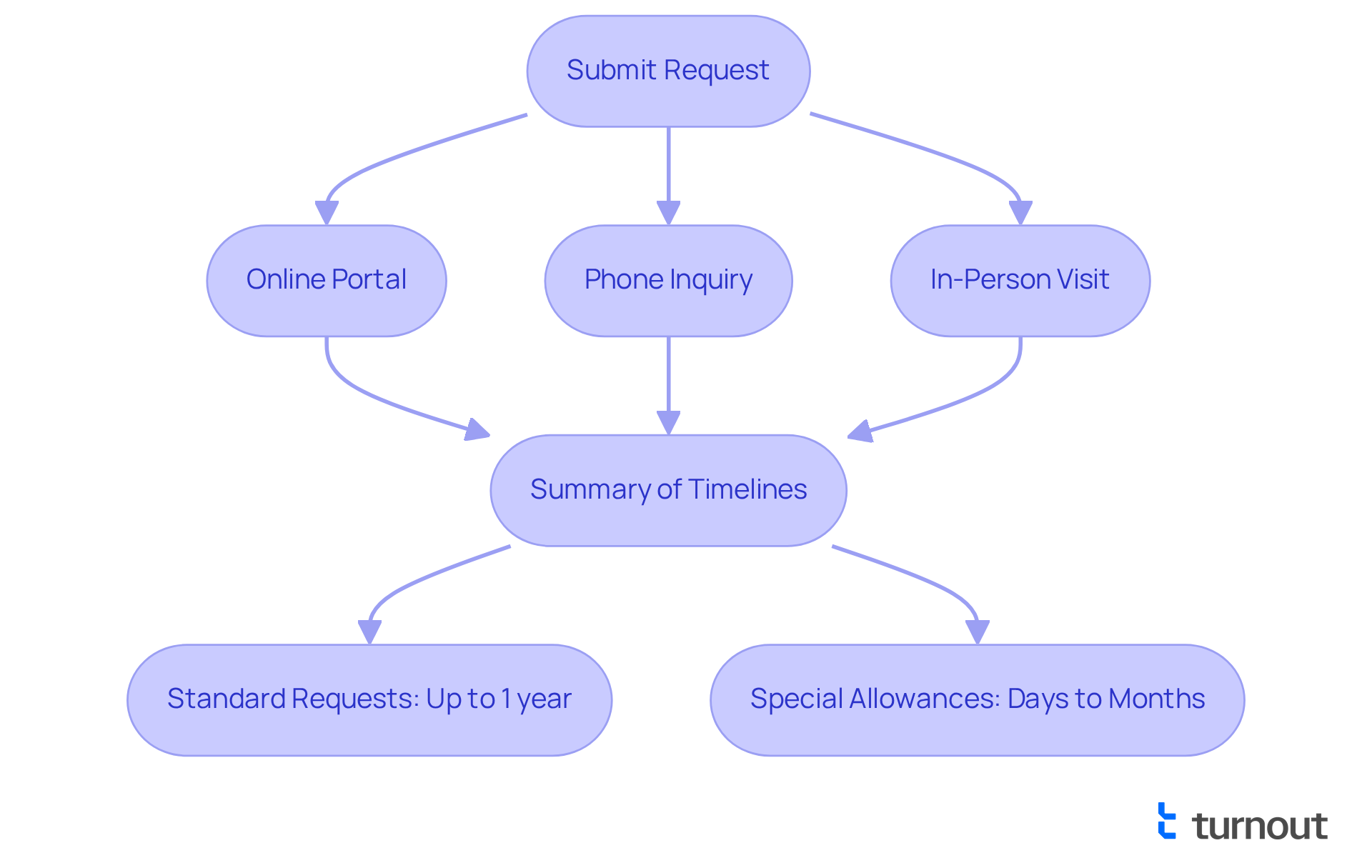Overview
Navigating the journey of securing a Social Security Administration (SSA) Compassionate Allowance can be overwhelming, especially for individuals facing serious health conditions. We understand that this process is crucial for those seeking expedited disability benefits. Here are five essential steps to help you through this journey.
- First, it’s important to understand your eligibility. Knowing whether you qualify can ease some of the stress.
- Next, gathering comprehensive documentation is key. This step ensures that your application is as strong as possible.
- Submitting your application correctly is another critical step. Attention to detail here can make a significant difference in the approval process.
- After submission, actively following up on your application status is vital. It’s common to feel anxious during this waiting period, but staying engaged can lead to faster approvals.
- Statistics show that those who follow these steps experience significantly reduced waiting times compared to standard claims.
Remember, you are not alone in this journey. We’re here to help you every step of the way.
Introduction
Navigating the complexities of disability benefits can feel overwhelming, especially for those facing serious health challenges. We understand that this journey can be daunting. The Social Security Administration's Compassionate Allowance Program shines as a beacon of hope, simplifying the approval process for individuals with specific life-threatening conditions.
This guide outlines five essential steps to secure these vital benefits, ensuring that you can access the financial support you urgently need. But what happens when the application process feels like too much to handle? How can you effectively navigate these intricacies to avoid delays? We're here to help you through this process.
Understand the Compassionate Allowance Program
The Empathetic Allowance Program, launched by the Social Security Administration (SSA), is designed to accelerate the handling of disability claims for individuals grappling with serious health issues. This initiative identifies specific diseases and situations that meet the SSA compassionate allowance criteria for immediate approval, significantly reducing the waiting time for much-needed benefits. As of 2025, the SSA compassionate allowance acknowledges over 250 conditions under the Special Allowance, demonstrating a commitment to addressing the urgent needs of those in critical health situations.
Conditions typically include:
- Advanced cancers
- Neurological disorders
- Other life-threatening illnesses
Advocates stress that utilizing the SSA compassionate allowance can be a game-changer, providing prompt support to those who need it the most. In April 2025, Social Security's 73.9 million beneficiaries received $134.5 billion, underscoring the importance of timely access to benefits for individuals in dire circumstances.
We understand that navigating the often complex landscape of disability benefits can be overwhelming. This program can facilitate quicker access to essential financial support for individuals facing significant challenges. For more information, visit the SSA Benevolent Allowances page. Remember, you are not alone in this journey; we’re here to help you find the support you need.

Determine Eligibility for Compassionate Allowance
We understand that navigating the Assistance program can be overwhelming. To start assessing your eligibility, check if your health issue is listed among the Social Security Administration's (SSA) allowances. This comprehensive list includes over 200 qualifying ailments, such as various cancers, neurological disorders, and other serious illnesses. You can easily access this list on the SSA's website.
Additionally, it's important to meet the general criteria for Social Security Disability Insurance (SSDI) or Supplemental Security Income (SSI). This requires having a medically determinable impairment that prevents you from engaging in substantial gainful activity.
The SSA prioritizes applicants for compassionate allowance, ensuring quicker handling of their cases. Requests for a compassionate allowance are typically processed faster than standard disability claims, allowing individuals to receive benefits within just a few weeks of submission.
If your situation isn't included but you believe it should be, you can submit a request for review to the SSA. This process involves providing detailed medical records to support your claim, which is essential for a smoother experience. It's common to feel uncertain, so staying updated on the SSA's requirements is crucial, as they regularly evaluate and adjust the list of qualifying conditions based on advancements in medical understanding.
If your application is denied, remember that you have the right to appeal the decision within 60 days. For further guidance, don't hesitate to consult the SSA's resources on eligibility criteria. You're not alone in this journey; we're here to help you every step of the way.

Gather Required Documentation for Your Application
When applying for a Supportive Allowance, we understand that gathering comprehensive documentation can feel overwhelming. However, this step is essential to bolster your claim. Here are some key items you will typically need:
- Medical Records: It's vital to include detailed medical records from your healthcare providers that outline your diagnosis, treatment history, and prognosis. Experts emphasize, "Without medical evidence to support your claim, it is very difficult to get approved for SSDI or SSI benefits." This highlights the critical role of robust medical documentation in securing SSDI benefits.
- Diagnostic Tests: Be sure to include results from relevant diagnostic tests, such as MRIs, CT scans, or blood tests, which confirm your condition. These documents illustrate the severity of your impairment.
- Personal Identification: Provide copies of your Social Security card, birth certificate, and any other identification documents to verify your identity.
- Work History: Documentation of your work history, including W-2 forms or pay stubs, is necessary to demonstrate your previous employment and earnings.
While the average number of documents submitted for SSA compassionate allowance requests in 2025 is expected to be substantial, it’s crucial to ensure that all documents are current and clearly legible. Remember, the more thorough your documentation, the smoother your process will be. Properly documenting your condition not only strengthens your claim for SSA compassionate allowance but also illustrates your commitment to managing your health, which the SSA closely evaluates.
We understand that inadequate documentation can lead to delays or denials, making it imperative to provide thorough and accurate records. You are not alone in this journey; we’re here to help you navigate through these challenges.

Submit Your Compassionate Allowance Application
We understand that applying for an SSA compassionate allowance can feel overwhelming. Once you have gathered all the necessary documentation, you can submit your application through one of the following methods:
- Online: Visit the SSA's website and complete the registration form online. This is the quickest technique and allows you to monitor your status easily.
- By Mail: Download and print the request form, complete it, and send it along with your documentation to your local SSA office. Remember to keep copies of everything you send.
- In-Person: You can also apply in person at your local SSA office. This option lets you ask questions and receive immediate assistance.
Regardless of the method you choose, it's essential to ensure that your submission for the SSA compassionate allowance is complete and precise to avoid any delays. For additional information on the enrollment process, we're here to help—refer to the SSA Apply page. You are not alone in this journey.

Follow Up and Understand the Approval Process
After submitting your request, we understand that following up is crucial to check its status. You can do this through several helpful methods:
- Online: Access the SSA's digital portal to track your status.
- Phone: Call the SSA's toll-free number at 1-800-772-1213 for inquiries regarding your request.
- In-Person: Visit your local SSA office for direct updates.
It's important to know that the approval procedure for special allowances is significantly faster than regular requests. Many cases are settled in as short as a week to several months. Cases involving SSA compassionate allowance are often decided within days rather than months, significantly reducing the waiting period compared to traditional claims, which can take up to a year. Understanding these timelines can help you manage your expectations effectively.
Advocates emphasize the importance of timely follow-ups. Proactive inquiries can further expedite the process. As one disability advocate noted, "Timely follow-ups can make a significant difference in how quickly your application is processed." Recent statistics indicate that follow-up inquiries can lead to faster resolutions, underscoring the importance of staying engaged throughout this journey. Remember, you are not alone in this process, and we’re here to help you every step of the way.

Conclusion
The SSA Compassionate Allowance Program serves as a vital lifeline for those grappling with severe medical challenges, expediting the disability claims process. This program is not only designed to identify qualifying conditions but also to ensure that individuals in urgent need receive the financial support they deserve as swiftly as possible. By understanding the intricacies of this program, applicants can significantly enhance their chances of receiving timely assistance.
Throughout this article, we have outlined key steps to navigate the application process effectively:
- Determining eligibility
- Gathering essential documentation
- Submitting applications
- Following up on requests
Each stage plays a crucial role in securing compassionate allowances. Emphasizing the importance of thorough preparation and proactive engagement, we provide a comprehensive roadmap to help you achieve your goals.
Ultimately, the significance of the SSA Compassionate Allowance Program cannot be overstated. It is a crucial resource that addresses the urgent needs of those battling life-threatening conditions. By staying informed and taking action, you can ensure that you are not only prepared but also empowered to access the benefits that can profoundly impact your life. Remember, support is available, and taking the first step can lead to much-needed relief.
Frequently Asked Questions
What is the Compassionate Allowance Program?
The Compassionate Allowance Program, launched by the Social Security Administration (SSA), is designed to expedite the handling of disability claims for individuals with serious health issues. It identifies specific diseases and situations that qualify for immediate approval, significantly reducing the waiting time for benefits.
How many conditions are recognized under the Compassionate Allowance Program?
As of 2025, the SSA recognizes over 250 conditions under the Compassionate Allowance Program, including advanced cancers, neurological disorders, and other life-threatening illnesses.
What are the benefits of the Compassionate Allowance Program?
The program provides prompt support to individuals facing significant health challenges by facilitating quicker access to financial support, allowing them to receive benefits within just a few weeks of submission.
How can I determine my eligibility for the Compassionate Allowance?
To assess your eligibility, check if your health issue is listed among the SSA's allowances, which includes over 200 qualifying ailments. You must also meet the general criteria for Social Security Disability Insurance (SSDI) or Supplemental Security Income (SSI), which requires having a medically determinable impairment that prevents you from engaging in substantial gainful activity.
What should I do if my condition is not listed but I believe it should be?
If your condition is not included in the list but you believe it qualifies, you can submit a request for review to the SSA, providing detailed medical records to support your claim.
How quickly are compassionate allowance requests processed?
Requests for compassionate allowances are typically processed faster than standard disability claims, allowing individuals to receive benefits within just a few weeks of submission.
What if my application for the compassionate allowance is denied?
If your application is denied, you have the right to appeal the decision within 60 days. It is advisable to consult the SSA's resources on eligibility criteria for further guidance.
Where can I find more information about the Compassionate Allowance Program?
More information can be found on the SSA's Benevolent Allowances page, which provides details about the program and the conditions it covers.




